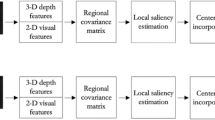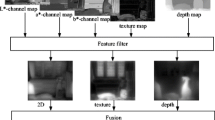Abstract
Recent studies have shown that a remarkable distinction exists between human binocular and monocular viewing behaviors. Compared with two-dimensional (2D) saliency detection models, stereoscopic three-dimensional (S3D) image saliency detection is a more challenging task. In this paper, we propose a saliency detection model for S3D images. The final saliency map of this model is constructed from the local quaternion Fourier transform (QFT) sparse feature and global QFT log-Gabor feature. More specifically, the local QFT feature measures the saliency map of an S3D image by analyzing the location of a similar patch. The similar patch is chosen using a sparse representation method. The global saliency map is generated by applying the wake edge-enhanced gradient QFT map through a band-pass filter. The results of experiments on two public datasets show that the proposed model outperforms existing computational saliency models for estimating S3D image saliency.




Similar content being viewed by others
References
Itti, L., Koch, C., & Niebur, E. (1998). A model of saliency-based visual attention for rapid scene analysis. IEEE Transactions on Pattern Analysis and Machine Intelligence, 20(11), 1254–1259.
Han, S., & Vasconcelos, N. (2010). Biologically plausible saliency mechanisms improve feedforward object recognition. Vision Research, 50(22), 2295–2307.
Felzenszwalb, P., McAllester, D., & Ramanan, D. (2008). A discriminatively trained, multiscale, deformable part model. In IEEE international conference on computer vision and pattern recognition, (pp. 1–8).
Liu, Y., Yang, J., Meng, Q., Lv, Z., et al. (2016). Stereoscopic image quality assessment method based on binocular combination saliency model. Signal Processing, 125, 237–248.
Jiang, Q., Shao, F., Jiang, G., et al. (2015). A depth perception and visual comfort guided computational model for stereoscopic 3D visual saliency. Signal Processing: Image Communication, 38, 57–69.
Shafieyan, F., Karimi, N., Mirmahboub, B., et al. (2017). Image retargeting using depth assisted saliency map. Signal Processing: Image Communication, 50, 34–43.
Lammar, M., Mitrea, M., Hasnaoui, M., et al. (2017). MPEG-4 AVC stream-based saliency detection. Application to robust watermarking. Signal Processing: Image Communication, 60, 116–130.
Srivastava, S., Mukherjee, P., & Lall, B. (2016). Adaptive image compression using saliency and KAZE features. In IEEE international conference on signal processing and communications (SPCOM), (pp. 1–5).
Wang, A., & Wang, M. (2017). RGB-D salient object detection via minimum barrier distance transform and saliency fusion. IEEE Signal Processing Letters, 24(5), 663–667.
Wang, J., Da Silva, M. P., Le Callet, P., et al. (2013). Computational model of stereoscopic 3D visual saliency. IEEE Transactions on Image Processing, 22(6), 2151–2165.
Kanan, C., Tong, M. H., Zhang, L., et al. (2009). SUN: Top-down saliency using natural statistics. Visual Cognition, 17(6–7), 979–1003.
Harel, J., Koch, C., Perona, P. (2006). Graph-based visual saliency. In Proceedings of advances in neural information processing systems (NIPS), (pp. 545–552).
Hou, X., & Zhang, L. (2007). Saliency detection: A spectral residual approach. In Computer vision and pattern recognition, (pp. 1–8).
Imamoglu, N., Lin, W., & Fang, Y. (2013). A saliency detection model using low-level features based on wavelet transform. IEEE Transactions on Multimedia, 15(1), 96–105.
Zhang, L., Gu, Z., & Li, H. (2013). SDSP: A novel saliency detection method by combining simple priors. In 20th IEEE international conference on image processing (ICIP), (pp. 3093–3096).
Fang, Y., Lin, W., Lee, B. S., et al. (2012). Bottom-up saliency detection model based on human visual sensitivity and amplitude spectrum. IEEE Transactions on Multimedia, 14(1), 187–198.
Zhang, L., Li, A., & Zhang, Z. (2016). Global and local saliency analysis for the extraction of residential areas in high-spatial-resolution remote sensing image. IEEE Transactions on Geoscience and Remote Sensing, 54(7), 3750–3763.
Fang, Y., Wang, J., Narwaria, M., et al. (2014). Saliency detection for stereoscopic images. IEEE Transactions on Image Processing, 23(6), 2625–2636.
Qi, F., Zhao, D., Liu, S., et al. (2017). 3D visual saliency detection model with generated disparity map. Multimedia Tools and Applications, 76(2), 3087–3103.
Wang, J., Da Silva, M. P., et al. (2013). Computational model of stereoscopic 3D visual saliency. IEEE Transactions on Image Processing, 22(6), 2151–2165.
Ju, R., Liu, Y., Ren, T., et al. (2015). Depth-aware salient object detection using anisotropic center-surround difference. Signal Processing: Image Communication, 38, 115–126.
Wang, A., & Wang, M. (2017). RGB-D salient object detection via minimum barrier distance transform and saliency fusion. IEEE Signal Processing Letters, 24(5), 663–667.
Jiang, Q., Shao, F., & Jiang, G. (2015). A depth perception and visual comfort guided computational model for stereoscopic 3D visual saliency. Signal Processing: Image Communication, 38, 57–69.
Fang, Y., Lei, J., Li, J., et al. (2017). Learning visual saliency from human fixations for stereoscopic images. Neurocomputing., 266, 284–292.
Ma, Y. C., & Hang, H. M. (2015). Learning-based saliency model with depth information. Journal of Vision, 15(6), 19.
Song, H., Liu, Z., Du, H. et al. (2016). Depth-aware saliency detection using discriminative saliency fusion. In: IEEE international conference on acoustics, speech and signal processing (ICASSP), (pp. 3093–3096).
Zhang, Q., Wang, X., Jiang, J. et al. (2016). Deep learning features inspired saliency detection of 3D images. In Pacific rim conference on multimedia, (pp. 580–589).
Fang, Y., Chen, Z., Lin, W., et al. (2012). Saliency detection in the compressed domain for adaptive image retargeting. IEEE Transactions on Image Processing, 21(9), 3888–3901.
Fang, Y., Lin, W., Lee, B. S., et al. (2012). Bottom-up saliency detection model based on human visual sensitivity and amplitude spectrum. IEEE Transactions on Multimedia, 14(1), 187–198.
Donoho, D. L. (2006). For most large underdetermined systems of linear equations the minimal l1-norm solution is also the sparsest solution. Communications on Pure and Applied Mathematics, 59(6), 797–829.
Tibshirani, R. (1996). Regression shrinkage and selection via the lasso, Journal of the Royal Statistical Society. Series B (Methodological), 267–288.
Zhang, L., Zhang, L., Mou, X., et al. (2011). FSIM: A feature similarity index for image quality assessment. IEEE Transactions on Image Processing, 20(8), 2378–2386.
Judd, T., Ehinger, K., Durand, F., et al. (2009). Learning to predict where humans look. In 12th IEEE international conference on computer vision (ICCV), (pp. 2106–2113).
Hamilton, W. R. (1848). XI. on quaternions; or on a new system of imaginaries in algebra. Philosophical Magazine Series 3, 25(163), 10–13.
Ell, T.A. (1993). Quaternion-Fourier transforms for analysis of two-dimensional linear time-invariant partial differential systems. In 32th IEEE conference on decision and control, (pp. 1830–1841).
Sangwine, S. J. (1996). Fourier transforms of colour images using quaternion or hypercomplex, numbers. Electronics Letters, 32(21), 1979–1980.
Ell, T. A., & Sangwine, S. J. (2007). Hypercomplex Fourier transforms of color images. IEEE Transactions on Image Processing, 16(1), 22–35.
Li, Y., Zhou, Y., & Xu, L. (2009) Incremental sparse saliency detection. In 6th IEEE international conference on image processing (ICIP), (pp. 3093–3096).
Lang, C., Nguyen, T.V., Katti, H. et al. (2012). Depth matters: Influence of depth cues on visual saliency. In European conference on computer vision (ECCV), (pp. 92–109).
Acknowledgements
This work was supported by the National Natural Science Foundation of China (Grant Nos. 61502429, 61505176), the Zhejiang Provincial Natural Science Foundation of China (Grant Nos. LY18F020012), the Zhejiang Open Foundation of the Most Important Subjects, and the China Postdoctoral Science Foundation (Grant No. 2015M581932).
Author information
Authors and Affiliations
Corresponding author
Rights and permissions
About this article
Cite this article
Cai, X., Zhou, W., Cen, G. et al. Saliency Detection for Stereoscopic 3D Images in the Quaternion Frequency Domain. 3D Res 9, 22 (2018). https://doi.org/10.1007/s13319-018-0169-8
Received:
Revised:
Accepted:
Published:
DOI: https://doi.org/10.1007/s13319-018-0169-8




